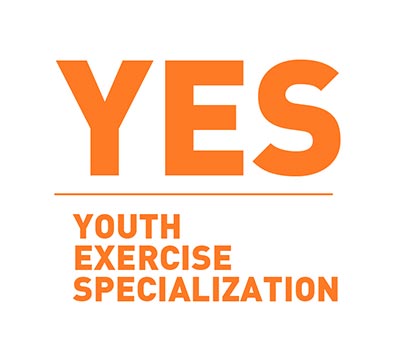NASM Youth Exercise Specialization (YES)english
Fitness en PT - verdieping
locations
- Self-study training (completely online)
course days
online
price
The '50% off' discount is valid until 30-04-2025
Deze actie loopt nog
14dagen11uur56min4sec
Dit online E-learning programma (zelfstudie) is Engelstalig!

Educate today's youth and tomorrow's athletes through practical fitness and nutrition planning with NASM's Youth Exercise Specialization.
What You’ll Learn
In the United States, the number of teenagers affected by obesity has nearly tripled since the 1970s. From lack of exercise to lack of motivation, online gaming to minimal school resources, there are several reasons why today's youth has fallen behind the curve when it comes to staying active.
That's why we've created a specialization for trainers who want to help reverse the problems facing today’s youth and face their challenges head-on. Through hands-on exercises and expert programming, you'll understand how to help keep kids motivated and engaged in sports, weightlifting, running, and more.
With this fully digital program, you'll learn about exercise variables and modifications for nutritional needs, cardiorespiratory, core, balance, plyometrics, and resistance training all geared towards younger populations. Plus, get everything you need to know about fitness assessments, psychological considerations, and how to grow your business by working with today's youth.
Help today's youth improve their physical activity level while having fun.
Learn how to keep kids motivated and engaged in sports and exercise.
Why Become a Youth Exercise Specialist?
- Tap into the growing demand for physical fitness experts for young people ages 6 to 19
- Show kids how to have fun while improving their sports skills, increasing their physical activity level, and losing weight
- Help curb the youth obesity trend with exercise and nutritional guidance
- Provide training solutions for after-school programs, youth sports teams, and the children of adult clients
- Boost your reputation, career, and client base by learning to train young people in groups or individually using the Optimum Performance Training (OPT™) Model
- Invest in your clients' lives and futures as well as your own!
Prerequisites
There are no prerequisites for this course. Although the course is primarily intended for personal trainers, fitness coaches, nutrition coaches and other fitness/health professionals, there is no requirement that you be one to take the course.
Section 1: The Science of Youth Exercise
Chapter 1: Rationale for Youth Fitness Training
This chapter will provide a better understanding of the different terms that identify the youth population, the difference between overweight and obesity, and be able to describe why so many youths are overweight.
Chapter 2: Anatomical and Physiological Considerations for Youth
Understand the key physiological differences between children, adolescents, and adults.
Chapter 3: Psychological Considerations for Youth
Self-perceptions and self-belief help the youth be successful in a fitness program. Provide young clients with tools and strategies to help better adapt activities and habits in pursuance of a fitness goals.
Section 2: Fitness & Training Guidelines for Youth
Chapter 4: Fitness Assessment for Youth
Be able to recognize the expectations for health and fitness professionals. Understand the special considerations for test administration in youth.
Chapter 5: Youth Flexibility Guidelines
Understand and provide general exercise guidelines and various flexibility options for youth.
Chapter 6: Cardiorespiratory Training for Youth
Understand and develop general cardiorespiratory training guidelines and programs for youth.
Chapter 7: Core and Balance Training Guidelines for Youth
Determine the appropriate core and balance exercise programs that are safe, effective, and fun for youth based on the OPT™ Model.
Chapter 8: Plyometric, Speed, Agility, and Quickness Training for Youth
Understand the importance of plyometric and speed, agility, and quickness training (SAQ) for youth. Determine appropriate exercises to incorporate into a youth programs based on the OPT™ Model.
Chapter 9: Resistance Training for Youth
Design and implement a safe, effective, and progressive resistance training program for youth, as well as eliminate myths about the safety of youth engaging in resistance training.
Section 3: Development for Youth Clients
Chapter 10: Integrated Program Design for Youth Clients
Be able to define cardiorespiratory stage training, the principles behind each stage, and how each stage fits into the OPT™ Model.
Chapter 11: Nutrition for Youth
Recognize the current trends of youth eating habits while understanding the effects of obesity on their population. Understand nutrition recommendations and basic fluid intake guidelines for youth.
Chapter 12: Professional Development
Understand the legal and ethical responsibilities related to a health and fitness professional working with youth.
Final Exam
After the completion of the course, you will take an online final exam from the comfort of your own home, or wherever you prefer to take tests. The exam has 60 questions with a time limit of 90 minutes. To pass, you need a score of 70% or higher. Don’t fret though, if you score below that, you have up to 3 attempts to pass.
Je bent hier:
Why EFAA courses?
- More than 35 years of experience
- Already trained more than 35,000 people
- Recognized by NL Actief
- European (EQF/eReps) recognition Europe Active
- Official training partner NASM
- Combination training online and practical learning
- Locations throughout the Netherlands
- Affordable combination and total packages
- Payment in installments possible
price
The '50% off' discount is valid until 30-04-2025
Deze actie loopt nog
14dagen11uur56min4sec
locations & start dates
Self-study training (completely online)
--



































